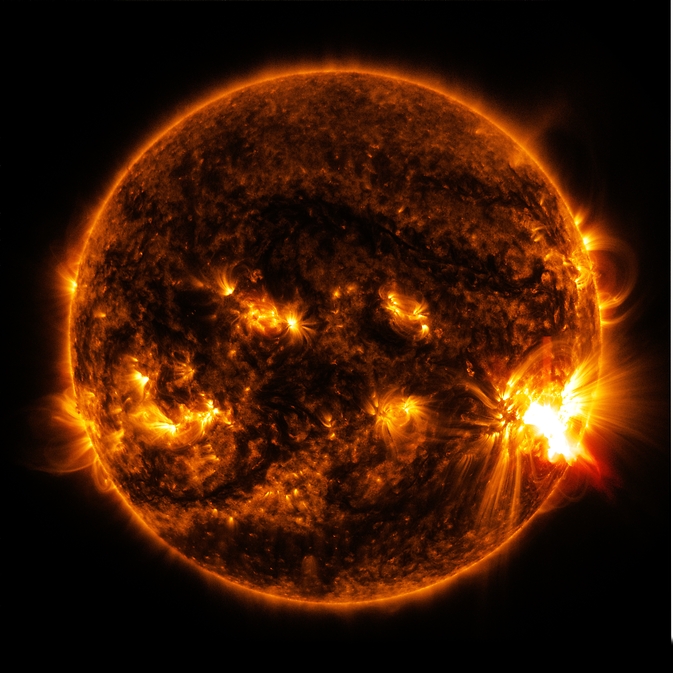NASA's SDO Observes More Flares Erupting from Giant Sunspot

NASA's Solar Dynamics Observatory captured this image of an X-class solar flare bursting off the lower right side of the sun on Oct. 27, 2014. The image shows a blend of extreme ultraviolet light with wavelengths of 131 and 171 Angstroms. Image Credit: NASA/SDO
X-class denotes the most intense flares, while the number provides more information about its strength. An X2 is twice as intense as an X1, an X3 is three times as intense, etc.
To see how this event may affect Earth, please visit NOAA's Space Weather Prediction Center at http://spaceweather.gov, the U.S. government's official source for space weather forecasts, alerts, watches and warnings.
Continuing a week's worth of substantial flares beginning on Oct.19, 2014, the sun emitted two mid-level solar flares on Oct. 26 and Oct. 27. The first peaked at 8:34 pm EDT on Oct. 26, 2014, and the second peaked almost 10 hours later at 6:09 am EDT on Oct. 27. NASA's Solar Dynamics Observatory, which constantly observes the sun, captured images of both flares.
Solar flares are powerful bursts of radiation. Harmful radiation from a flare cannot pass through Earth's atmosphere to physically affect humans on the ground, however — when intense enough — they can disturb the atmosphere in the layer where GPS and communications signals travel.
To see how this event may affect Earth, please visit NOAA's Space Weather Prediction Center at http://spaceweather.gov, the U.S. government's official source for space weather forecasts, alerts, watches and warnings.
The first flare was classified as an M7.1-class flare. The second flare was a bit weaker, classified as an M6.7-class.
M-class flares are one tenth as strong as X-class flares, which are the most intense flares. The number provides more information about its strength. An M2 is twice as intense as an M1, an M3 is three times as intense, etc.
The series of flares over the course of the previous week all erupted from a particularly large active region on the sun, labeled AR 12192 – the largest seen on the sun in 24 years. Active regions are areas of intense and complex magnetic fields that are often the source of solar flares.
Active regions are more common at the moment as we are in what's called solar maximum, which is the peak of the sun's activity, occurring approximately every 11 years.
What is a solar flare?
For answers to this and other space weather questions, please visit the Spaceweather Frequently Asked Questions page.
Related Links
› Download high resolution media from all flares from AR2192
› What does it take to be X-class?
› View Past Solar Activity
Karen C. Fox
NASA's Goddard Space Flight Center, Greenbelt, Md.
Media Contact
All latest news from the category: Physics and Astronomy
This area deals with the fundamental laws and building blocks of nature and how they interact, the properties and the behavior of matter, and research into space and time and their structures.
innovations-report provides in-depth reports and articles on subjects such as astrophysics, laser technologies, nuclear, quantum, particle and solid-state physics, nanotechnologies, planetary research and findings (Mars, Venus) and developments related to the Hubble Telescope.
Newest articles

Bringing bio-inspired robots to life
Nebraska researcher Eric Markvicka gets NSF CAREER Award to pursue manufacture of novel materials for soft robotics and stretchable electronics. Engineers are increasingly eager to develop robots that mimic the…

Bella moths use poison to attract mates
Scientists are closer to finding out how. Pyrrolizidine alkaloids are as bitter and toxic as they are hard to pronounce. They’re produced by several different types of plants and are…

AI tool creates ‘synthetic’ images of cells
…for enhanced microscopy analysis. Observing individual cells through microscopes can reveal a range of important cell biological phenomena that frequently play a role in human diseases, but the process of…





















